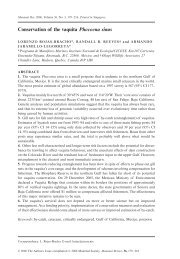Dumont et al. 2006 - The Department of Ecology and Evolutionary ...
Dumont et al. 2006 - The Department of Ecology and Evolutionary ...
Dumont et al. 2006 - The Department of Ecology and Evolutionary ...
Create successful ePaper yourself
Turn your PDF publications into a flip-book with our unique Google optimized e-Paper software.
1242 M. G. <strong>Dumont</strong> <strong>et</strong> <strong>al</strong>.orf2154 dnaJ gloBtrkA mptG folC folK pmoC pmoA pmoB bolA cobS cobT orf5501 moxFFig. 2. Gen<strong>et</strong>ic map <strong>of</strong> ORFs identified on clone GSC357. <strong>The</strong> fragment is 15.2 kb in length. <strong>The</strong> assigned names represent the closest knowngenes (refer to Table 1).1kbE. coli TransforMax EC300 cells provided with the vector(Epicentre).An<strong>al</strong>ysis <strong>of</strong> the SIP labelling <strong>and</strong> the m<strong>et</strong>agenomic libraryBacteri<strong>al</strong> 16S rRNA genes were amplified from the 12 C-DNA <strong>and</strong> 13 C-DNA by PCR <strong>and</strong> an<strong>al</strong>ysed by denaturinggradient gel electrophoresis (DGGE) (Fig. 1B). <strong>The</strong> DGGEpattern for the 12 C-DNA was complex, as expected for asoil bacteri<strong>al</strong> community. <strong>The</strong> DGGE pattern for the 13 C-DNA showed less than 10 predominant b<strong>and</strong>s. Sequencing<strong>of</strong> the dominant 13 C-DNA DGGE b<strong>and</strong>s indicated thepresence <strong>of</strong> the m<strong>et</strong>hanotrophic genera M<strong>et</strong>hylobacter(GS_b<strong>and</strong>_2), M<strong>et</strong>hylocella (GS_b<strong>and</strong>_4) <strong>and</strong> M<strong>et</strong>hylocystis(GS_b<strong>and</strong>_5) (Fig. 1B). <strong>The</strong> M<strong>et</strong>hylocystis 16SrRNA sequence was very similar to the UP4, UP5, UP6<strong>and</strong> UP7 16S rRNA sequences (AY080911, AY080917,AY080912, AY080914 respectively) that tog<strong>et</strong>her constituted96% <strong>of</strong> the 16S rRNA gene sequences from the 13 C-DNA in the origin<strong>al</strong> 13 CH 4 SIP an<strong>al</strong>ysis <strong>of</strong> this forest soil(Radajewski <strong>et</strong> <strong>al</strong>., 2002). In addition to the m<strong>et</strong>hanotroph16S rRNA gene sequences, a predominant sequenc<strong>et</strong>ype (GS_b<strong>and</strong>_1) was present with similarity to theBacteroid<strong>et</strong>es <strong>and</strong> a second type (GS_b<strong>and</strong>_3) with similarityto a Gammaproteobacteria; the latter was <strong>al</strong>sor<strong>et</strong>rieved in the previous SIP study <strong>of</strong> this forest soil(Radajewski <strong>et</strong> <strong>al</strong>., 2002).After construction <strong>of</strong> the m<strong>et</strong>agenomic library from 13 C-DNA, the plasmids were isolated from 48 clones chosenat r<strong>and</strong>om <strong>and</strong> an<strong>al</strong>ysed by digestion with BamHI followedby agarose gel electrophoresis. Most clones containedinserts b<strong>et</strong>ween 10 <strong>and</strong> 30 kb <strong>and</strong> two <strong>of</strong> the 48 plasmidscontained no visible insert DNA. Also, nearly h<strong>al</strong>f <strong>of</strong> theclones an<strong>al</strong>ysed had addition<strong>al</strong> BamHI sites within theinsert fragment (results not shown), which indicated thatthe cloned 13 C-DNA had been incompl<strong>et</strong>ely digested asintended, or <strong>al</strong>ternatively had been parti<strong>al</strong>ly protectedfrom cutting by m<strong>et</strong>hylation. <strong>The</strong> sequencing primers T7<strong>and</strong> RP2 anne<strong>al</strong>ed adjacent to the cloning site <strong>of</strong>pCC1BAC <strong>and</strong> were used to sequence the ends <strong>of</strong>sever<strong>al</strong> <strong>of</strong> the cloned inserts. <strong>The</strong> sequence data from theclones were compared with the GenBank database byBLAST an<strong>al</strong>ysis (Altschul <strong>et</strong> <strong>al</strong>., 1990) <strong>and</strong> were differentfrom each other, with the exception <strong>of</strong> two clones thatappeared to be identic<strong>al</strong>. None <strong>of</strong> the genes identified byend sequencing were <strong>of</strong> obvious relevance to m<strong>et</strong>hylotrophy<strong>and</strong> these clones were not sequenced further.<strong>The</strong> m<strong>et</strong>agenomic library was screened by colonyhybridization for pmoA, mmoX <strong>and</strong> mxaF, which encodesubunits <strong>of</strong> the pMMO, soluble m<strong>et</strong>hane monooxygenase<strong>and</strong> m<strong>et</strong>hanol dehydrogenase respectively. Polymerasechain reaction primers were used to amplify the probeusing the 13 C-DNA as template. As the probes were amplifiedfrom 13 C-DNA, there was a high probability that thehomologous probe would be present for a cloned gene.<strong>The</strong> three gene hybridizations were performed separately<strong>and</strong> a tot<strong>al</strong> <strong>of</strong> four membranes each with approximately575 clones were hybridized with 32 P-GTP r<strong>and</strong>om primedPCR probes.<strong>The</strong> mmoX <strong>and</strong> mxaF probes did not hybridize with any<strong>of</strong> the clones in the library. Two clones, GSC357 (GisburnSoil Clone) <strong>and</strong> GSC1346, hybridized strongly to thepmoA probe <strong>and</strong> the pmoA gene could be amplified fromthese clones by PCR (results not shown). <strong>The</strong> restrictionfragment length polymorphism (RFLP) patterns <strong>of</strong>GSC357 <strong>and</strong> GSC1346 digested with NotI were identic<strong>al</strong>(results not shown). GSC357 was compl<strong>et</strong>ely sequencedusing a shotgun approach. <strong>The</strong> compl<strong>et</strong>e sequence was15 230 bp <strong>and</strong> a summary <strong>of</strong> the genes contained on thisplasmid <strong>and</strong> their arrangement is given in Fig. 2 <strong>and</strong>Table 1. GSC1346 was parti<strong>al</strong>ly sequenced <strong>and</strong> found tobe very similar to the sequence <strong>of</strong> GSC357. It is likely thatGSC357 <strong>and</strong> GSC1346 were from different strains <strong>of</strong> thesame species.An<strong>al</strong>ysis <strong>of</strong> the pmoCAB operon on clone GSC357GSC357 contained a compl<strong>et</strong>e pmoCAB operon, withpmoC, pmoA <strong>and</strong> pmoB <strong>of</strong> 765 bp, 759 bp <strong>and</strong> 1257 bprespectively. <strong>The</strong> intergenic region b<strong>et</strong>ween pmoC <strong>and</strong>pmoA was 269 bp <strong>and</strong> b<strong>et</strong>ween pmoA <strong>and</strong> pmoB was227 bp. <strong>The</strong> sequences <strong>of</strong> pmoCAB operons <strong>and</strong> derivedpolypeptide sequences demonstrated considerable similarityto those <strong>of</strong> M<strong>et</strong>hylocystis sp. strain M (Gilbert <strong>et</strong> <strong>al</strong>.,2000), M<strong>et</strong>hylosinus trichosporium OB3b (Gilbert <strong>et</strong> <strong>al</strong>.,2000), M<strong>et</strong>hylocystis sp. strain SC2 (Ricke <strong>et</strong> <strong>al</strong>., 2004)<strong>and</strong> M<strong>et</strong>hylococcus capsulatus (Bath) (Semrau <strong>et</strong> <strong>al</strong>.,1995; Stolyar <strong>et</strong> <strong>al</strong>., 1999) (Table 2). Putative ribosomebinding sites were present upstream (5′) <strong>of</strong> <strong>al</strong>l three pmogenes on the clone. <strong>The</strong> pmoCAB operon in M<strong>et</strong>hylocystis© <strong>2006</strong> <strong>The</strong> AuthorsJourn<strong>al</strong> compilation © <strong>2006</strong> Soci<strong>et</strong>y for Applied Microbiology <strong>and</strong> Blackwell Publishing Ltd, Environment<strong>al</strong> Microbiology, 8, 1240–1250




